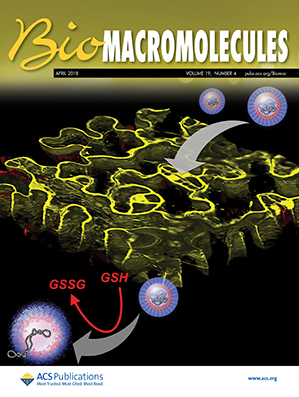通过酰胺功能化聚己内酯改善药物传递:增强负载能力和持续药物释放。
IF 5.4
2区 化学
Q1 BIOCHEMISTRY & MOLECULAR BIOLOGY
引用次数: 0
摘要
聚合物胶束是一种有效的药物传递手段,但往往存在不稳定、载药能力低、药物过早泄漏等问题。本文中,我们报道了双取代γ-酰胺功能化ε-己内酯(ε-CL)单体使每个聚合物单元的取代基密度增加了一倍,从而增强了胶束性质并改善了药物传递应用。合成了3种具有2个丙基、2个苄基和丙基-苄基组合的疏水单体ε-CL。以聚乙二醇(PEG)为宏观引发剂和亲水性嵌段,采用开环聚合的方法对所得单体进行聚合。合成的共聚物成功地自组装形成胶束,并将阿霉素(DOX)加载到所有胶束中。聚(乙二醇)-b-聚(n -丙基- n -苄基-7-氧氧烷-4-羧酰胺)(PEG-b-PBnPyCL)在酸性条件下具有7.33 wt %的DLC, ph响应药物释放。此外,负载dox的PEG-b-PBnPyCL胶束在MDA-MB-231癌细胞中表现出近20%的细胞活力。这些结果有助于推进聚合物胶束作为具有临床翻译潜力的药物载体。本文章由计算机程序翻译,如有差异,请以英文原文为准。
Improved Drug Delivery through Amide-Functionalized Polycaprolactones: Enhanced Loading Capacity and Sustained Drug Release
Polymeric micelles are effective for drug delivery but often face instability, low drug loading capacity (DLC), and premature drug leakage. Herein, we report that disubstituted γ-amide functionalized ε-caprolactone (ε-CL) monomers double the substituent density per polymeric unit, enhancing micelle properties and improving drug delivery applications. Three hydrophobic ε-CL monomers with two propyl groups, two benzyl groups, and a combination of propyl and benzyl groups were synthesized. The obtained monomers were polymerized by ring-opening polymerization using poly(ethylene glycol) (PEG) as a macroinitiator and the hydrophilic block. The synthesized copolymers successfully self-assembled to form micelles, and doxorubicin (DOX) was loaded into all micelles. Poly(ethylene glycol)-b-poly(N-propyl-N-benzyl-7-oxopane-4-carboxamide) (PEG-b-PBnPyCL) exhibited 7.33 wt % DLC with pH-responsive drug release in acidic conditions. In addition, the DOX-loaded micelles of PEG-b-PBnPyCL exhibited nearly 20% cell viability in MDA-MB-231 cancer cells. These results contribute to advancing polymeric micelles as drug carriers with clinical translation potential.
- Download: Download high-res image (169KB)
- Download: Download full-size image
求助全文
通过发布文献求助,成功后即可免费获取论文全文。
去求助
来源期刊

Biomacromolecules
化学-高分子科学
CiteScore
10.60
自引率
4.80%
发文量
417
审稿时长
1.6 months
期刊介绍:
Biomacromolecules is a leading forum for the dissemination of cutting-edge research at the interface of polymer science and biology. Submissions to Biomacromolecules should contain strong elements of innovation in terms of macromolecular design, synthesis and characterization, or in the application of polymer materials to biology and medicine.
Topics covered by Biomacromolecules include, but are not exclusively limited to: sustainable polymers, polymers based on natural and renewable resources, degradable polymers, polymer conjugates, polymeric drugs, polymers in biocatalysis, biomacromolecular assembly, biomimetic polymers, polymer-biomineral hybrids, biomimetic-polymer processing, polymer recycling, bioactive polymer surfaces, original polymer design for biomedical applications such as immunotherapy, drug delivery, gene delivery, antimicrobial applications, diagnostic imaging and biosensing, polymers in tissue engineering and regenerative medicine, polymeric scaffolds and hydrogels for cell culture and delivery.
 求助内容:
求助内容: 应助结果提醒方式:
应助结果提醒方式:


